Brain Storm 2012
SARINA SATURN
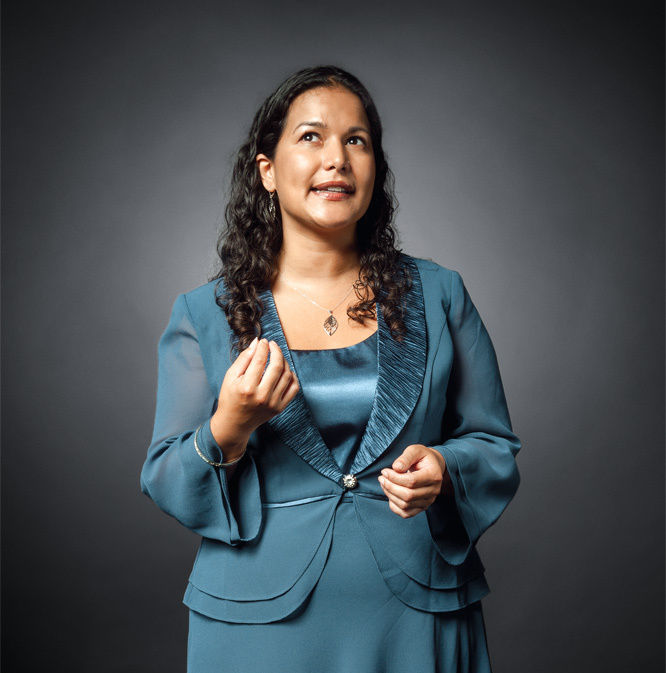
Image: Nicolle Clemetson
The science of empathy
Like many neuroscientists, Sarina Saturn began her career on the dark side. “I was all doom and gloom,” the 37-year-old Oregon State University researcher says. “We have such a pathological bias. All the funding is for researching depression.”
Unlike others, however, the Portland native has turned that inclination on its head in a career that’s taken her from New York University’s influential LeDoux lab to Berkeley to Corvallis. Saturn’s key work probes why and how we feel confident and socially connected. Her headline-grabbing finding is that our DNA has a lot to do with how smoothly we interact with others. Her more radical conclusion is that people can use that discovery to live better lives.
Saturn’s research focuses on how our genes affect our bodies’ response to oxytocin, a hormone that helps the body weather primal stress (like childbirth) and floods a woman’s body when she nurses an infant. Oxytocin also seems linked to social trust, love, and physical relaxation—“warm fuzzies,” as Saturn puts it.
A single genetic combination governs how efficiently an individual person’s cells can use oxytocin. Saturn is the first researcher to examine how variations in that sequence affect how well people both deal with stress and show empathy. Basically, her work splits humanity into two groups: call them the oxytocin rich (about 25 percent of us), and the oxytocin poor (the rest). Those whose cells make the best use of the hormone do considerably better than others in tests of social fluency—like the ability to recognize others’ emotions just by looking at their eyes. They also cope better with nerve-fraying blasts of headphone noise.
Saturn spent her early career “scaring poor rats to see what they did” and examining brain issue under microscopes. But her recent research leaves her determined to build bridges between hard, lab-based neuroscience and the nuance of social science. “Neuroscientists have always made fun of psychologists for lacking rigor,” she says. “And psychologists have always asked neuroscientists, ‘How can you study love in the lab?’ But the two fields are starting to have a common language.”
A search for reconciliation may be part of Saturn’s own nature—born Sarina Rodrigues, she traces her roots to India and the Marianas Islands and notes, with amusement, that she often must decline invitations to join Hispanic groups. Today, Saturn says she is on a “spiritual quest to help people lead healthier and happier lives,” and views her exploration of the hardwired roots of behavior as a call for compassion, more than fatalism.
“Nature colors our traits, but we can affect how we express those traits. And if we understand that, maybe we can give each other and ourselves a break sometimes.” —ZD
JESSICA GREEN
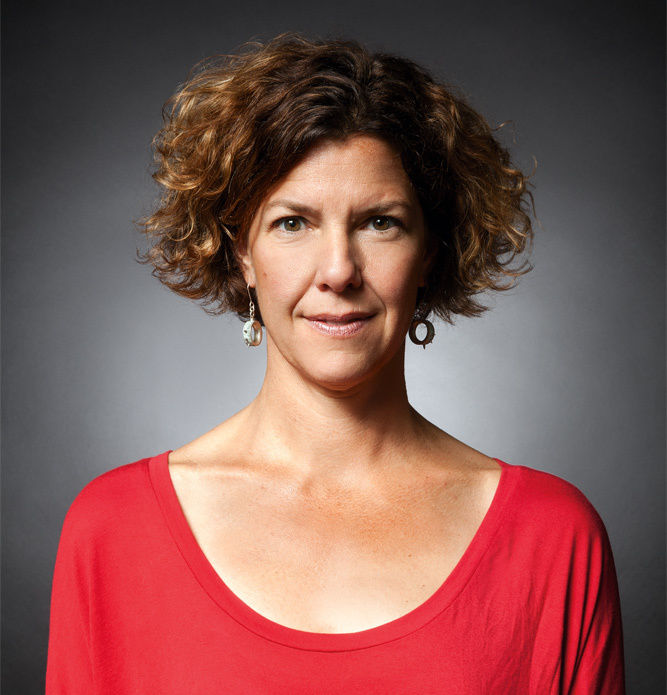
Image: Nicolle Clemetson
The biology of indoor ecosystems
Like a tropical rain forest teeming with birds, bugs, and plants, every human being is a walking ecosystem of microbes. Each one of our bodies’ cells is outnumbered by 10 bacterial cells—living things that can be hostile or beneficial. The air we breathe and the surfaces we touch are similarly wild with life. Yet modern buildings, the primary habitat for billions of humans, shape (and may damage) these invisible ecosystems in ways we don’t understand.
“We know far more about the rain forest than we know about the air around us all the time,” says Jessica Green, a 43-year-old cofounder of the University of Oregon’s Biology and the Built Environment Center. Green studies the microorganisms that inhabit the enclosed spaces where urbanized humans spend almost all of their time. She brings a hunch to this work: that modernity has become too sterile.
Green’s research shows that the sealed windows, insulation, and mechanically filtered, heated, and cooled air typical of modern buildings turn rooms into the microbial equivalent of single-species tree farms. “Intuitively, you don’t want a monoculture anywhere,” she says, “whether it’s in a wild forest or your garden. But buildings create monocultures all around us.” In the process, she notes, mechanical systems gobble lots of electricity.
To contrast indoor environments, Green and her colleagues compare the air and surfaces of rooms with open windows to those served only by mechanical ventilation. In one hospital setting they studied, open windows fostered a robust microbial mix, similar to that found outdoors on plants and in soil. In rooms full of ventilated air, the microbes were much less diverse, their populations very similar to those found on human skin. “In other words,” Green says, “we’re often essentially breathing ourselves.”
Green acknowledges that we don’t fully understand the consequences of living in such “static, homogenous” environments. But she points to established health concerns about the overuse of
antibiotics, and the “hygiene hypothesis,” the idea that excessive cleanliness contributes to asthma and allergies. Her UO team, which includes biologists and an architect, aims to learn whether buildings designed to allow greater microbial diversity could be both healthier and more energy efficient.
“We see biology as a potential link between architecture, energy use, and human health,” Green says. “The energy and resources we spend getting rid of microbes are mostly an illusion. You can’t have microbe-free skin or air. The question is, what kind of environments are we creating?” —ZD
JIM SOLBERG
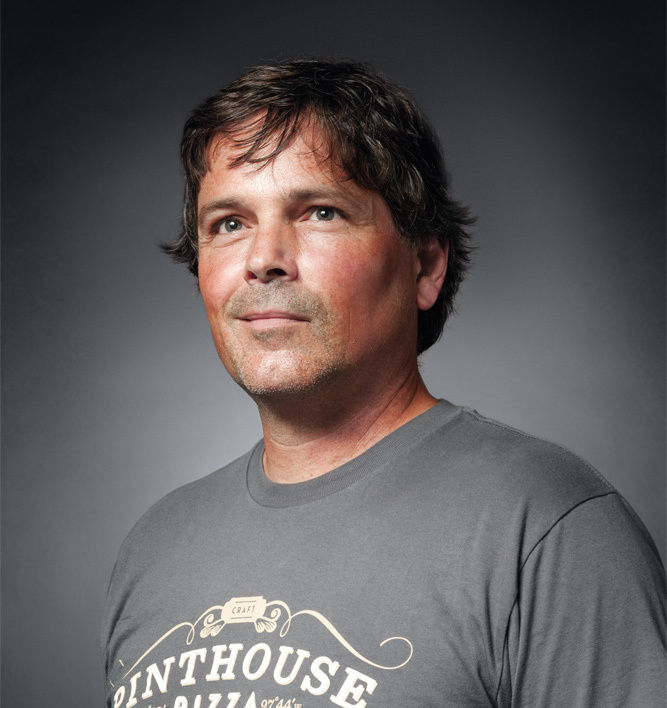
Image: Nicolle Clemetson
A new beginning for Oregon hops
In late 2008, with the global financial crack-up at its bleakest, two men sat at a Portland bar. Punch line? Beer can make a great economic stimulant.
One of the pair, Jim Solberg, had left his job as a Nike executive a few years before. (He says of his 16-year run helping build the company’s international apparel business: “Sometimes, in business, the higher you go, the less fun it becomes.”) His friend, Roger Worthington, was a successful—and unsatisfied—lawyer. They mused on what their futures might hold, and found an answer in the bottoms of their glasses.
“We thought there could be opportunity in Oregon hops,” says Solberg, now a 51-year-old whose relaxed demeanor belies his past as a Stanford football player. The two grew up among the hops farms of the Willamette Valley. “So I did some research. And what I found was flat-out chaos.”
Oregon hops farmers, once go-to suppliers to the nation’s leading breweries, faced alarming decline in demand (resulting in fewer acres planted) as corporate brewing shifted to hops varieties better grown elsewhere. Meanwhile, the rapidly expanding ranks of craft brewers, who had always relied on corporate breweries’ leftover hops, faced high prices and feared future shortages.
“No brewer ever had to plan ahead, and no hops supplier existed solely to supply the craft beer market,” Solberg says. He and his partner decided to become that supplier.
Today, IndieHops, their three-year-old company, sells hops grown at small Oregon farms to craft producers here and elsewhere. To do so, IndieHops had to design, engineer, and build its own mill—Oregon’s first—for processing 200-pound bales of hops into the tiny pellets brewers use. Someday, the firm may be better known for transforming the possibilities of the crop at the center of its business.
Solberg, who runs IndieHops’ day-to-day operations, also discovered that Oregon State’s nationally significant hops-breeding program faced elimination. (Anheuser-Busch once largely funded OSU’s research; in 2008, a Belgian conglomerate took over AB and soon withdrew support.) With $1 million, IndieHops rescued and redirected the research, which now aims to develop new varieties of hops—and thus new flavors—for craft brewers to use and Oregon farmers to plant.
IndieHops already offers hops with flavors like “mixed berry” or “orange peel.” Breeding new varieties takes years, but within a decade, the research Solberg’s company funds may mean an even more wide-ranging selection of tastes.
Well beyond one night’s beery idea, IndieHops’ combination of research, agriculture, industrial processing, and craft commerce exemplifies a synthesizer’s approach to complex projects. “We are re-orienting a whole industry’s machinery,” Solberg says. “That means farmers, brewers, and scientists. I say I’m not an expert in anything—except how to find experts.” —ZD
TAD MCGEER
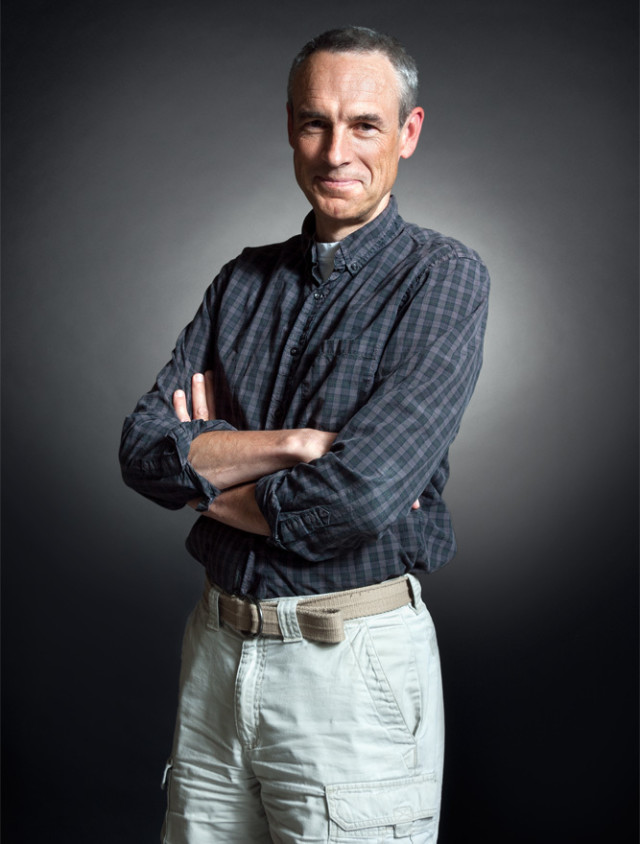
Tad McGeer
Image: Nicolle Clemetson
Pioneering unmanned aircraft
Tad McGeer’s house, located north of the Columbia River Gorge amid pastures and grazing cows, hardly suggests the reinvention of an industry. In the two-car garage, however, an engineer monitors the exhaust of a fist-size, gas-powered engine. Inside, others hunch over kitchen countertops or sit on beige carpet, assembling plastic and metal parts.
“We don’t need a room full of computers,” says McGeer, 54. “What we’re building isn’t very big, so we don’t need lots of space.”
This is Aerovel, the company McGeer founded in 2006 to prototype a new aerial drone design. McGeer helped pioneer the unmanned-aircraft industry, launching landmark designs and starting the field’s top company. Today, he leads his own small team and aims for the drone world’s next great advance. Aerovel’s product, called Flexrotor, may make possible a light and quiet aircraft that can move both vertically and horizontally. Some industry experts predict that Flexrotor’s ingenious multidirectional propeller will mostly replace current drone designs by the middle of the decade.
Constant news reports about Predator strikes on the Pakistani border and predictions that surveillance drones may become commonplace over the United States have given unmanned aircraft a somewhat ominous reputation. McGeer sees—and seeks to foster—the technology’s potential for good.
“We want to do weather reconnaissance,” he says. “Geological surveys. Reconnaissance for fishing boats and the Coast Guard. Atmospheric research. Environmental research. Those would all be nice to do.”
A native of Vancouver, BC, McGeer earned a degree in aeronautical engineering from Stanford in 1983. It didn’t take him long to grow disillusioned with the stagnant commercial aircraft industry. (McGeer notes that the Boeing 787 took a decade to design and represents only a minor advance.) In 1992, he founded a company called Insitu and soon launched the ScanEagle, the first small unmanned vehicle practical to launch and retrieve from a ship or small boat.
By the early 2000s, Insitu grew into a dynamo, largely because of the US military’s splurge on drone technology. The company employed fewer than 10 people in 1994, when it moved to Hood River. Now, its more than 750 engineers and other workers have established the Gorge as the industry’s de facto drone capital. McGeer, frustrated by the company’s military focus, left in 2005, but retained an ownership stake. Boeing bought Insitu for $400 million in 2008, providing McGeer with an undisclosed but substantial amount of seed money for Aerovel.
The Flexrotor has already completed several successful test flights, and McGeer hopes to have a fully functional version ready for the market in 2013. For all his scientific idealism, McGeer is also pragmatic. His new company has already received some money and considerable interest in the Flex-rotor from the military.
“I’m not crazy about supporting ill-conceived wars,” he says. “But military uses aren’t inherently evil. If we’re going to achieve what we want in civil applications, we need volume. And to achieve volume, we need customers.” —Marty Patail
DAVID MONETTE
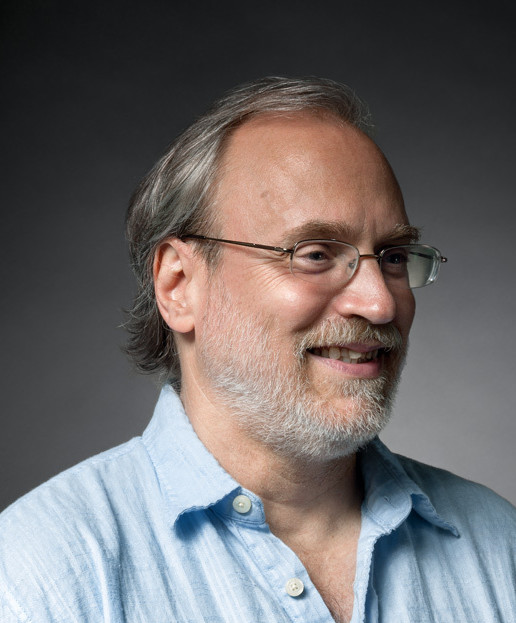
Image: Nicolle Clemetson
Revolutionizing the horn
If you’ve never played trumpet, you likely don’t realize that beneath the instrument’s gleaming brass lurks a treacherous beast. The humdrum job of hitting a high “C”—which pianists accomplish with a shrug and a keystroke—is a beginning player’s nightmare. Running through a simple scale without blowing sharp or flat takes years of practice. Even master players can flail.
In 1975, Dave Monette—then a trumpet player in a dance band in Kalamazoo, Michigan—got so frustrated with this diabolical instrument that he quit the band and went to work in a JC Penney. “It drove me nuts,” he recalls. An obsessive tinkerer, Monette asked himself: could he build a better horn?
The trumpet’s basic design hadn’t changed much since the piston valve became popular more than a century ago. Originally tempered for the key of A, the horn was modified to play the more popular key of B-flat. This innocent alteration meant endless headaches for generations of players who would be flummoxed by how sound resonates within the instrument—high notes often sound flat, low notes sharp. Veteran players learn to compensate, but Monette didn’t see why they should have to. “The modern trumpet is very young on the evolutionary scale,” he says. “I wanted to sound better when I played without having to work so hard.”
Monette got a job as an instrument repairman in Wills Music Store in Salem, Oregon. After rebuilding hundreds of trumpets (each one typically has over 150 components), he zeroed in on the most troublesome element: the mouthpiece.
Bringing an eccentric skill set to the task—he is both a ham radio operator and a practitioner of kundalini yoga—Monette merged an engineer’s approach to soundwave dynamics with a guru’s reverence for mystical good vibrations. After two years of work, he developed a mouthpiece that was heavier and larger than previous versions. The Monette mouthpiece was (cue fanfare) an instant sensation. Meanwhile, he began to squeeze and stretch the trumpet’s inner chambers to produce richer and more resonant sounds.
Before long, top players from around the world were flying in to visit his shop in Northeast Portland. Now he turns out trumpets for the likes of Wynton Marsalis, who calls him “the greatest trumpet maker in the world.” The average waiting time for a new horn is 12 to 14 months, but the 56-year-old Monette refuses to hurry. “I’m not anti-mass production,” he says. “But I’d rather make a few instruments that sound great than a lot that sound goofy.”
His sleek, bullet-train-like trumpets don’t come cheap—an entry-level model costs $10,000—but when you listen to Marsalis swing a tune like “After You’ve Gone,” you understand the price tag. “That’s why we’re here,” Monette says. “My motto is more music, less work.”
—Chris Lydgate
ANDY FRICHTL
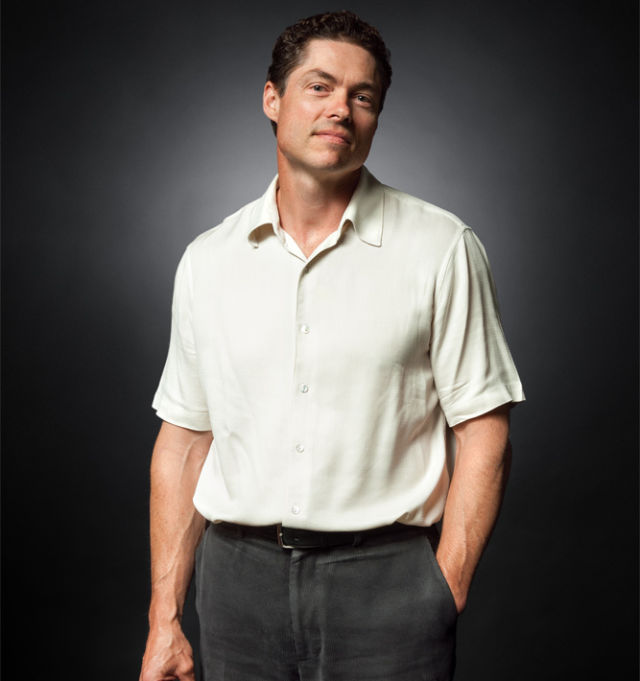
Image: Nicolle Clemetson
Portland’s green engineering mind
For an insight into how Andy Frichtl thinks about sustainability, visit his land 30 feet from the edge of the Lower Columbia when a spring storm piles fallen cedar trees on the riverbank. Frichtl reels in these fallen giants with a homemade winch and mills them into beautiful board-and-batten siding. He gives the salvaged wood a new permanent home, nailing it to one of five buildings he’s restoring on the property.
This arm’s-length search for efficiency epitomizes the work of the 46-year-old leader of Interface Engineering, a firm that employs 200, bills $30 million a year, and has become one of the catalytic forces taking Portland’s green-building industry to the larger world. Frichtl has designed mechanical systems—typically heating, cooling, and water—for many of the region’s landmark sustainable projects, and his portfolio is rapidly growing to encompass China and the Middle East. His first move, Frichtl says, is always “figuring out the best resource that’s sitting right in front of you.”
Consider a recent Interface project: the San Ysidro US Port of Entry between Tijuana and San Diego, currently under construction. With few cold days, heating needs at the world’s busiest land port can be met by a simple bioreactor that processes all waste on-site. Double-sided photovoltaic panels will capture both the direct rays from the nearly cloudless sky and solar energy that bounces off the pavement below. Water left over from the bioreactor’s sewage treatment will cool those photovoltaics, which operate more efficiently at lower temperatures.
“The extra costs everyone throws out for building more sustainably are all a bunch of garbage,” says the 1990 PSU grad. “We should be designing every building for at least net-zero energy use right now. You only get one chance at these buildings. Like my cabin, they’re going to be around for 50 years.”
—Randy Gragg
COLLEEN FLANIGAN
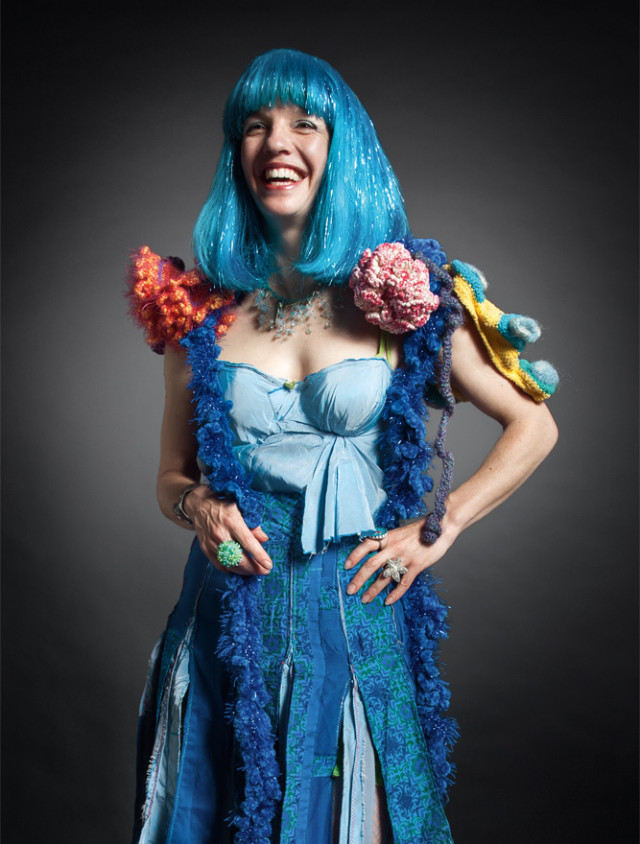
Colleen Flanigan
Image: Nicolle Clemetson
The underwater artist of coral
Many artists take inspiration from nature. “I prefer to collaborate with it,” says Colleen Flanigan. This alliance can take many forms, at many scales. Consider Miss Snail Pail, the 41-year-old Portland artist’s yarn-haired, shell-encrusted performance persona: a “snail abatement specialist” who, for about $20, teaches people how to turn the plant-munching pests into iron-rich gourmet meals. Or “Project Snip,” in which Flanigan invited colleagues at a recent TED global conference to give her a “crowd-sourced haircut.” Each barber’s perception of this intimate experience joined samples from the harvest in Flanigan’s journal.
Now beam to a much grander canvas in this eclectic creative force’s oeuvre: the ocean, and Flanigan’s “collaboration” with coral to build underwater sculptures-cum-reefs. Using a combination of steel, titanium, and electricity, Flanigan rehabilitates endangered habitat while raising awareness about coral’s ecological importance and aesthetic beauty.
“There is a pandemic going on among corals,” Flanigan says. Pollution—particularly acidification—and dynamite fishing are damaging much of the world’s reef habitat. “My hope is that my caring for them grows new solutions.”
With a design degree from UCLA and training as a metalsmith and jeweler, Flanigan has long regarded any material, from marshmallows to yarn tufts, as fair game. Coral joined her palette at a sustainable architecture conference in 2003, where she learned about Biorock, a system that stimulates metals submerged in seawater with low-voltage electrical charges, causing a limestone skin to form over the metals’ surface. The resulting alkaline-rich stone attracts ocean life and becomes a fertile new habitat for coral-reef species. As the first visual artist to be certified in Biorock creation, Flanigan built three coral sculptures: One in Cancun, inspired by a DNA helix, awaits the arduous contracting process required to install anything in sensitive reef areas. The other works are in the world’s largest Biorock park in Pemuteran, Bali.
“They’re like topiaries—they lose a lot of their form as they are grown over,” says Flanigan of the undersea installations. “I’m influenced by surrealism: the unexpected coming together and finding ways to convey deep truth.” —RG
GENEVIEVE BELL
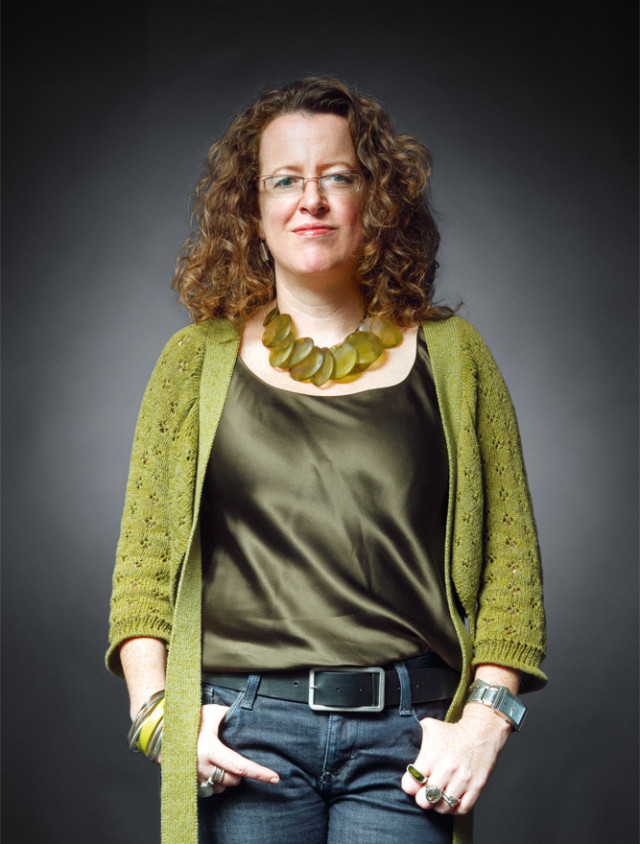
Image: Nicolle Clemetson
Intel’s social and cultural thinker
When Genevieve Bell first joined Intel in 1998, she was one of the oddest hires in the company’s history. “I came out of academia,” Bell, a trained anthropologist, recalls. “I was female. I was full of noise and enthusiasm.” For months, she struggled just to understand what her new colleagues were talking about. Fourteen years later, however, Bell has become one of the world’s foremost thinkers on how people use the arsenal of personal technology that now surrounds us. She leads a team of 90 social scientists, designers, and engineers who apply insights from observing everyday life to Intel’s work. The team has shaped products from silicon wafers to the low-cost Classmate PC—but Bell maintains that its real contribution is cultural.
“Products come and go,” she says. “The real measure of our work is, does Intel understand what people want? I don’t think they did 10 years ago. I think we’re starting to now.”
Bell almost missed this unusual calling. Born in Australia to an anthropologist mother and an engineer father, she describes herself as growing up “feral”—hunting for food and sleeping outside—on far-flung research sites. After relocating to the United States for an undergraduate degree at Bryn Mawr and an anthropology doctorate at Stanford, a long academic career beckoned. A chance meeting in the Bay Area redirected her toward the tech industry.
At the time, Intel was looking to add social scientists to its Hillsboro milieu in hopes of echoing the successful use of anthropological insight at Xerox’s Palo Alto Research Center in the late ’70s. The courtship took six months. “I kept asking, ‘But what will I do?’” Bell recalls. “They kept saying, ‘Well, you seem interesting.’ And I had to find my nerve. I had a tenure-track job and knew exactly what the next seven years would look like, down to the quarter. Intel couldn’t tell me what I’d do on Day Two.”
To a degree, Bell functions as an in-house agitator—she calls herself a “tremendous irritant”—for the importance of social and cultural observation. (She is one of only three women among the company’s “fellows,” a title reserved for its highest technical achievers and thinkers.) One of her key early insights was that most people in the world experience computing via cheap mobile phones, not pricey laptops. More recently, she’s argued that women, not men, truly drive the spread of technology. “Franklin and Tesla might have harnessed electricity,” she says, “but my grandmother in Australia had to work out how to manage it in the home.” In the future, she aims to guide designers toward simpler, easier-to-use technology.
“I realized we’d made an impact when Paul Otellini, the CEO, stood up at our biggest company event and said, ‘The future of computing is about experiences,’” Bell says. “Every year before that, he’d hold up silicon wafers.” —Taylor Clark
